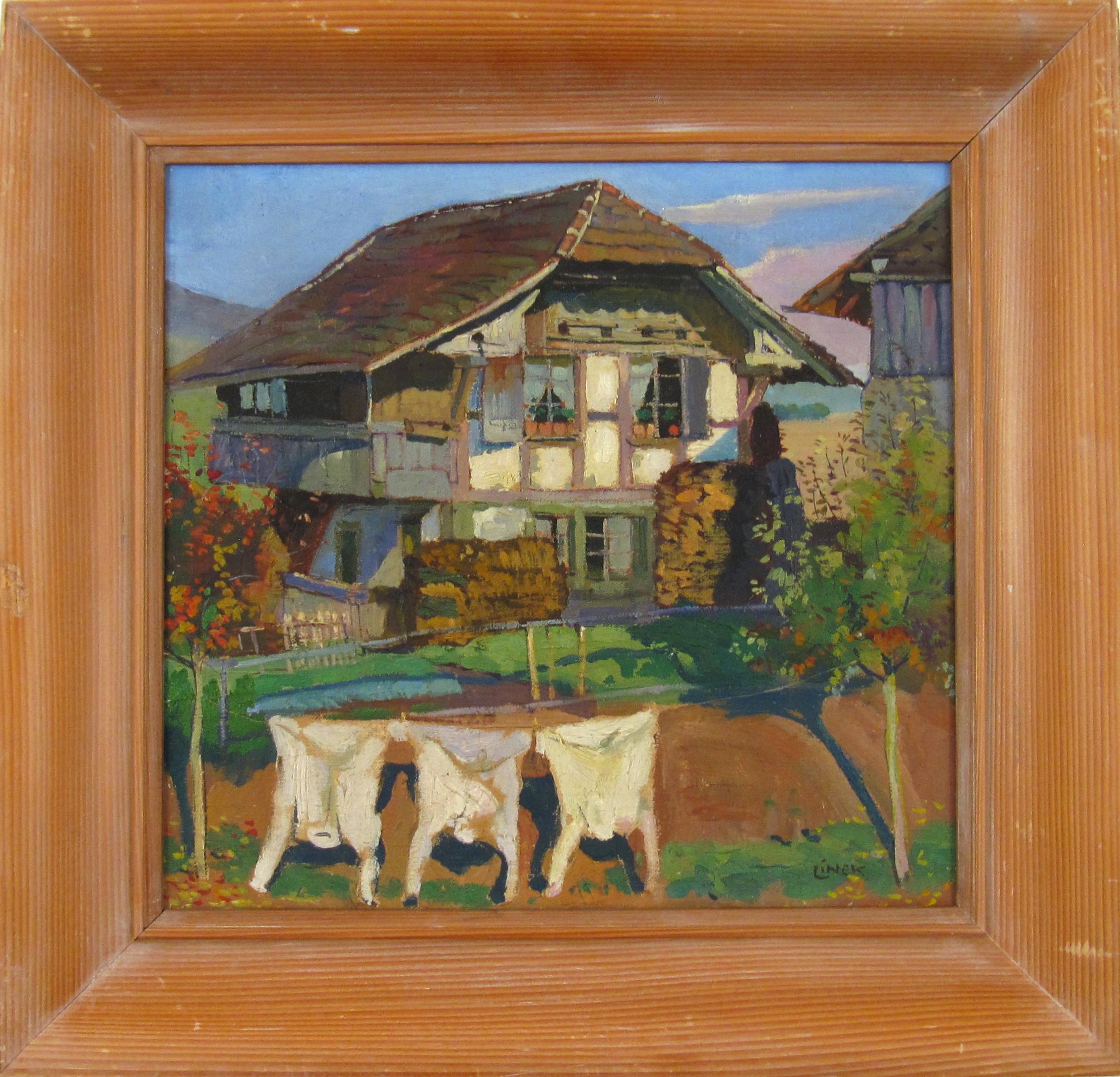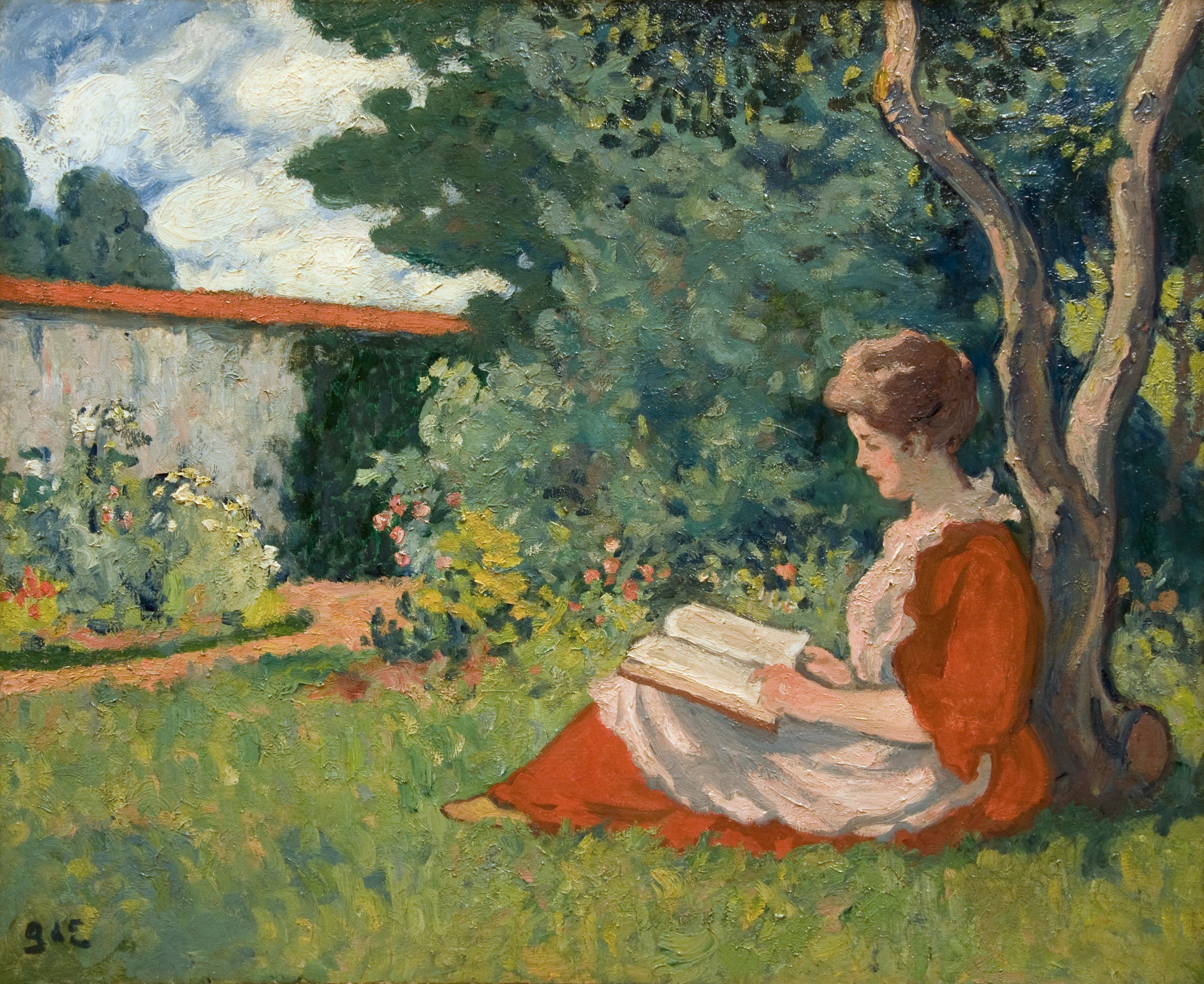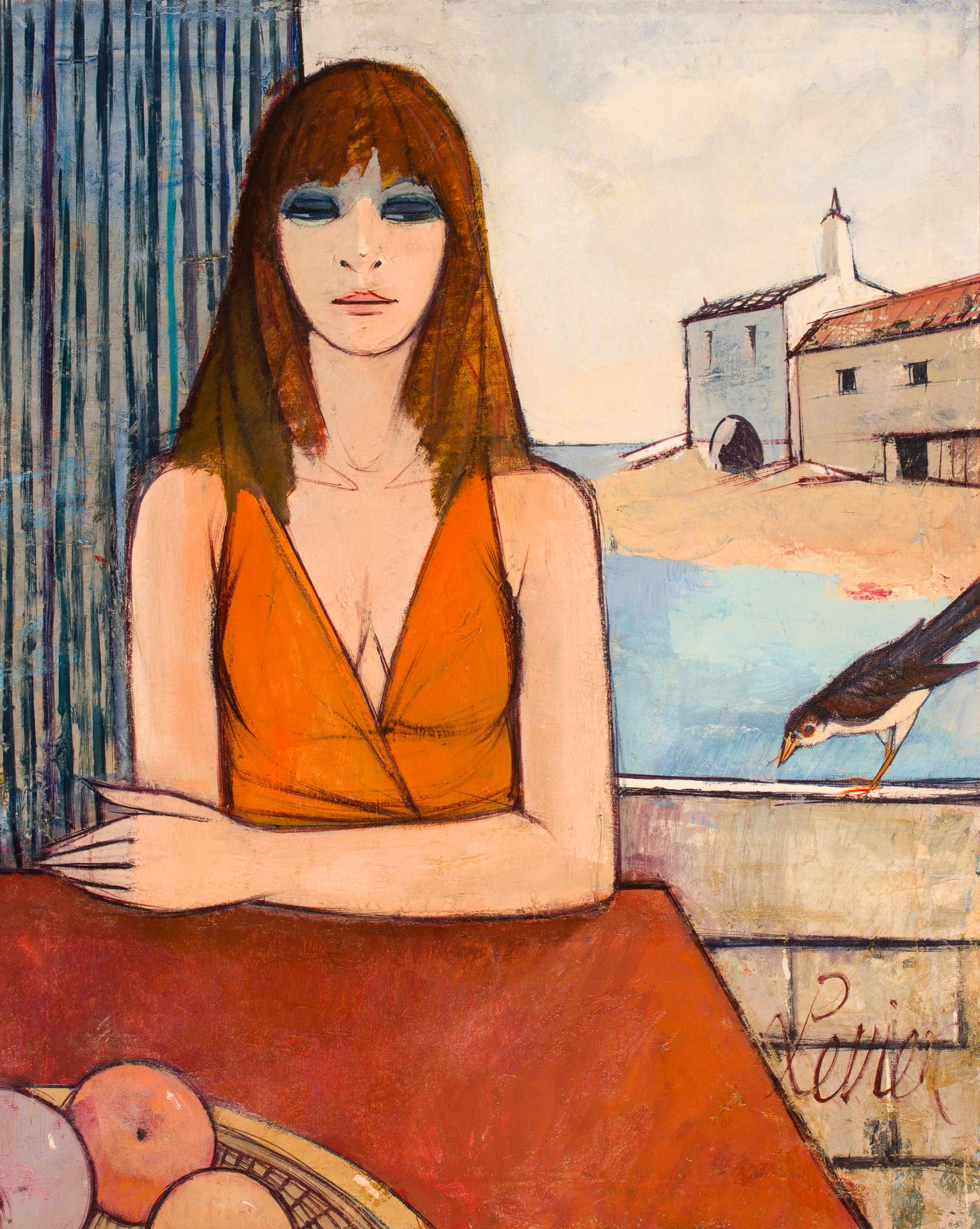Items Similar to Le Piège à Oiseaux
Want more images or videos?
Request additional images or videos from the seller
1 of 5
Georges d'EspagnatLe Piège à Oiseaux
About the Item
Georges D'espagnat
French, 1870 - 1950
Le Piège à Oiseaux
Signed gdE (lower right)
Oil on canvas
66 3/4 by 48 1/2 in. W/frame 70 ¾ by 52 ½ in.
Born at Melun on 14th August 1870, Georges d’Espagnat went on to become one of the most individualistic of 20th century French painters. Although associated with many of the greatest names in 20th century art, and though his work has at various times been identified as Fauve, Nabis or just plain Impressionist, he retained his own individuality. As Bénézit notes: “D’Espagnat, sans cesser d’être un Indépendant, a pris une place marquante parmi les maîtres modernes.”
Having moved to Paris at the age of 18 he declined the academic training of the Ecole des Beaux-Arts and chose instead to independently study the works of the Old Masters in the Louvre. He also travelled to Italy where he particularly admired the work of the Venetians, Titian and Tintoretto. In 1891 he took part in the Salon des Refusés and in the following year exhibited four paintings at the Salon des Indépendants.
In 1895 he had his first one-man show in Paris and three years after that a show of his work was held at Durand-Ruel Gallery, an association that was to continue for the rest of his life including exhibitions at their New York gallery. Though he himself never quite achieved the greatness of his peers, he was associated with greatness for much of his life. A close friendship with Renoir was only terminated by the master’s death in 1919, a group exhibition of 1907 at the Marcel Bernheim Gallery included himself, Bonnard, Cézanne, Matisse, Pissarro, Rouault, Seurat and Toulouse-Lautrec while a later exhibition at the same venue in 1926 consisted of d’Espagnat, André, Bonnard, Braque, Chagall, Matisse, Picasso and Signac. From 1936 onwards he served as a Professor at the Ecole Nationale Superieure des Beaux-Arts in Paris and he died in the French capital on 17th April, 1950. In the following year he was honoured by a retrospective exhibition at the Salon d’Automne, of which he had been Vice-President for many years.
Examples of his work are in many of the world’s most important museums including the Museum of Fine Arts, Boston, the Musée Royal des Beaux-Arts, Brussels, the Metropolitan Museum of Art, New York, the Art Institute, Chicago, the Pushkin Museum, Moscow, the Musée d’Orsay and the Musée d’Art Moderne, Paris, and the National Museum of Western Art, Tokyo.
Authentication:
This work will be included in the forthcoming catalogue raisonné being prepared by Jean-Dominique Jacquemond.
Provenance:
Schoneman Galleries, Inc., New York
Private Collection, New York (acquired from the above in 1968)
Acquired from the above
Le Trianon Fine Art & Antiques
Art D256
- Creator:Georges d'Espagnat (1870-1950, French)
- Dimensions:Height: 66.75 in (169.55 cm)Width: 48.5 in (123.19 cm)Depth: 1 in (2.54 cm)
- More Editions & Sizes:66 3/4 by 48 1/2 in. W/frame 70 ¾ by 52 ½ in.Price: $64,500
- Medium:
- Movement & Style:
- Period:
- Condition:
- Gallery Location:Sheffield, MA
- Reference Number:
About the Seller
3.7
Vetted Seller
These experienced sellers undergo a comprehensive evaluation by our team of in-house experts.
1stDibs seller since 2017
46 sales on 1stDibs
Typical response time: Several days
- ShippingRetrieving quote...Ships From: Sheffield, MA
- Return PolicyThis item cannot be returned.
More From This SellerView All
- Woman and ChildBy John Edward CostiganLocated in Sheffield, MAJohn Edward Costigan, N.A. American, 1888-1972 Woman and Child Oil on canvas Signed ‘J.E. Costigan N.A.’ lower left 24 by 30 in. W/frame 32 by 38 in. John Costigan was born of Irish-American parents in Providence, Rhode Island, February 29, 1888. He was a cousin of the noted American showman, George M. Cohan, whose parents brought the young Costigan to New York City and was instrumental in starting him on a career in the visual arts. They were less successful in encouraging him to pursue formal studies at the Art Students League (where, however, he later taught) than in exposing him to the commercial art world through the job they had gotten him with the New York lithographing firm that made their theatrical posters. At the H. C. Miner Lithographing Company, Costigan worked his way up from his entry job as a pressroom helper, through various apprenticeships, to the position of sketch artist. In the latter capacity he was an uncredited designer of posters for the Ziegfeld Follies and for numerous silent films. Meanwhile, he had supplemented his very meager formal studies in the fine arts with a self-teaching discipline that led to his first professional recognition in 1920 with the receipt of prizes for an oil painting and watercolor in separate New York exhibitions. A year earlier, Costigan had wed professional model Ida Blessin, with whom he established residence and began raising a family in the sleepy little rural New York hamlet of Orangeburg, the setting for the many idyllic farm landscapes and wood interiors with which he was to become identified in a career that would span half a century. John Costigan’s first national recognition came in 1922 with his winning of the coveted Peterson Purchase prize of the Art Institute of Chicago for an oil on canvas, “Sheep at the Brook.” It marked the start of an unbroken winning streak that would gain him at least one important prize per year for the remainder of the decade. The nation’s art journalists and critics began to take notice, making him the recurring subject of newspaper features and magazine articles. The eminent author and critic Edgar Holger Cahill was just a fledgling reporter when he wrote his first feature, “John Costigan Carries the Flame,” for Shadowland Magazine in 1922. Costigan had his first one-man show of paintings at the Rehn Gallery on New York’s 5th Avenue in November, 1924, to be followed less than three years later by another at the Art Institute of Chicago. In addition, Costigan’s work has been—and continues to be included, side-by-side with that of some of America’s most high-profile artists, in museum and gallery exhibitions throughout the country. His renown had peaked in the early 1930s, by which time his work had been honored with nearly every major award then being bestowed in the fine arts and had been acquired for the permanent collections of several prestigious American museums, including New York’s Metropolitan (which only recently, in 1997, deaccessioned his “Wood Interior,” acquired in 1934). Although Costigan’s celebrity had ebbed by the late 1930s, the Smithsonian Institution saw fit in 1937 to host an exhibition exclusively of his etchings. And, in 1941, the Corcoran Gallery (also Washington, D.C.) similarly honored him for his watercolors. (Another Washington institution, the Library of Congress, today includes 22 Costigan etchings and lithographs in its permanent print collection.) During World War II, Costigan returned briefly to illustrating, mainly for Bluebook, a men’s pulp adventure magazine. A gradual revival of interest in his more serious work began at the end of the war, culminating in 1968 with the mounting of a 50-year Costigan retrospective at the Paine Art Center and Arboretum in Oshkosh, Wisconsin. Oils, watercolors and prints were borrowed from museums and private collections throughout the country, and the exhibition was subsequently toured nationally by the Smithsonian Institution. John Costigan died of pneumonia in Nyack, NY, August 5, 1972, just months after receiving his final prestigious award —the Benjamin West Clinedinst Medal of the Artist’s Fellowship, Inc., presented in general recognition of his “...achievement of exceptional artistic merit...” in the various media he had mastered in the course of his career. This painting depicts one of the artist's favorite themes --the farm family bathing...Category
1940s Post-Impressionist Landscape Paintings
MaterialsOil
- Les VendangesBy Georges d'EspagnatLocated in Sheffield, MAGeorges d'Espagnat French, 1870 - 1950 Les Vendanges Signed gdE (lower left) Oil on canvas 67 by 43 in. W/frame 71 by 47 in. Born at Melun on 14th August 1870, Georges d’Espagnat...Category
1910s Post-Impressionist Figurative Paintings
MaterialsOil
- Djeuner ChamptreBy Marcel DyfLocated in Sheffield, MAMarcel Dyf French, 1899-1985 Djeuner Champtre Oil on canvas 23 ½ by 28 ¾ in. W/frame 31 ½ by 36 ¾ in. Signed lower left Marcel Dyf (Marcel Dreyfus) was born in Paris on October 7,...Category
1950s Post-Impressionist Figurative Paintings
MaterialsOil
- Woman in KimonoBy Everett Lloyd BryantLocated in Sheffield, MAEverett Lloyd Bryant American, 1864-1945 Woman in Kimono Oil on canvas Signed lower right 30 by 25 in. W/frame 35 by 30 in. Everett studied wit...Category
1920s Post-Impressionist Figurative Paintings
MaterialsOil
- BathersBy John Edward CostiganLocated in Sheffield, MAJohn Edward Costigan, N.A. American, 1888-1972 Bathers Oil on canvas Signed ‘J.E. Costigan N.A.’ lower left 20 by 24 in. W/frame 26 by 30 in. John Costigan was born of Irish-American parents in Providence, Rhode Island, February 29, 1888. He was a cousin of the noted American showman, George M. Cohan, whose parents brought the young Costigan to New York City and was instrumental in starting him on a career in the visual arts. They were less successful in encouraging him to pursue formal studies at the Art Students League (where, however, he later taught) than in exposing him to the commercial art world through the job they had gotten him with the New York lithographing firm that made their theatrical posters. At the H. C. Miner Lithographing Company, Costigan worked his way up from his entry job as a pressroom helper, through various apprenticeships, to the position of sketch artist. In the latter capacity he was an uncredited designer of posters for the Ziegfeld Follies and for numerous silent films. Meanwhile, he had supplemented his very meager formal studies in the fine arts with a self-teaching discipline that led to his first professional recognition in 1920 with the receipt of prizes for an oil painting and watercolor in separate New York exhibitions. A year earlier, Costigan had wed professional model Ida Blessin, with whom he established residence and began raising a family in the sleepy little rural New York hamlet of Orangeburg, the setting for the many idyllic farm landscapes and wood interiors with which he was to become identified in a career that would span half a century. John Costigan’s first national recognition came in 1922 with his winning of the coveted Peterson Purchase prize of the Art Institute of Chicago for an oil on canvas, “Sheep at the Brook.” It marked the start of an unbroken winning streak that would gain him at least one important prize per year for the remainder of the decade. The nation’s art journalists and critics began to take notice, making him the recurring subject of newspaper features and magazine articles. The eminent author and critic Edgar Holger Cahill was just a fledgling reporter when he wrote his first feature, “John Costigan Carries the Flame,” for Shadowland Magazine in 1922. Costigan had his first one-man show of paintings at the Rehn Gallery on New York’s 5th Avenue in November, 1924, to be followed less than three years later by another at the Art Institute of Chicago. In addition, Costigan’s work has been—and continues to be included, side-by-side with that of some of America’s most high-profile artists, in museum and gallery exhibitions throughout the country. His renown had peaked in the early 1930s, by which time his work had been honored with nearly every major award then being bestowed in the fine arts and had been acquired for the permanent collections of several prestigious American museums, including New York’s Metropolitan (which only recently, in 1997, deaccessioned his “Wood Interior,” acquired in 1934). Although Costigan’s celebrity had ebbed by the late 1930s, the Smithsonian Institution saw fit in 1937 to host an exhibition exclusively of his etchings. And, in 1941, the Corcoran Gallery (also Washington, D.C.) similarly honored him for his watercolors. (Another Washington institution, the Library of Congress, today includes 22 Costigan etchings and lithographs in its permanent print collection.) During World War II, Costigan returned briefly to illustrating, mainly for Bluebook, a men’s pulp adventure magazine. A gradual revival of interest in his more serious work began at the end of the war, culminating in 1968 with the mounting of a 50-year Costigan retrospective at the Paine Art Center and Arboretum in Oshkosh, Wisconsin. Oils, watercolors and prints were borrowed from museums and private collections throughout the country, and the exhibition was subsequently toured nationally by the Smithsonian Institution. John Costigan died of pneumonia in Nyack, NY, August 5, 1972, just months after receiving his final prestigious award —the Benjamin West Clinedinst Medal of the Artist’s Fellowship, Inc., presented in general recognition of his “...achievement of exceptional artistic merit...” in the various media he had mastered in the course of his career. This painting depicts one of the artist's favorite themes --the farm family bathing...Category
1950s Post-Impressionist Figurative Paintings
MaterialsOil
- A Day at the BeachLocated in Sheffield, MALeonce De Joncieres French, 1871-1947 A Day at the Beach Oil on canvas Signed and dated 'L. de Joncieres/ 1903' (lower right) 46 1/2 by 65¼ in. W/f...Category
Early 1900s Impressionist Landscape Paintings
MaterialsOil
You May Also Like
- David R Buchanan 'Men at Work' oil circa 1930Located in Frome, SomersetDavid R. Buchanan 20th Century British. 'Men at Work' circa 1930's oil on canvas 45cmx60cm good quality gallery frame 61cmx76cm A dymanic scene of a gang of road workers laying mains...Category
1930s Post-Impressionist Figurative Paintings
MaterialsOil
- A. J. Bennett - Light and Shade - Post Impressionist Painting, South Africa 1919Located in Meinisberg, CHA. J. Bennett (South African, fl. Early 20th century) Light and Shade • Oil on canvas artist board ca. 42.5 x 29.5 cm • Later frame ca. 53.5 x 41 cm Worldwide shipping is complime...Category
1910s Post-Impressionist Figurative Paintings
MaterialsCanvas, Oil, Board
- Femme lisant dans un jardinBy Georges d'EspagnatLocated in Washington, DCSigned with monogram lower left * The Robert Lehman Collection at the Metropolitan Museum of Art contains more paintings (nine) by Georges D’Espagnat than any other nineteenth- or ...Category
1910s Post-Impressionist Figurative Paintings
MaterialsCanvas, Oil
- PrintempsBy Charles LevierLocated in Costa Mesa, CAA beautiful woman sits at an open window, gazing down at a small bird who has landed nearby in this serene portrait by Charles Levier. Warm orange tones are played off their complements in shades of blue, the artist utilizing several different layers of oils to create a subtle and relaxed view of a spring day near the sea. Beyond the window a small chapel sits on a peninsula, surrounded tranquil blue waters. This work, like many of Levier's, belongs to the French figurative movement of the Glorious Thirty (Les Trente Glorieuses) - the golden period of thirty years after WWII which were a time of great hope and prosperity in France. Inspired by Hollywood cinema, Charles Levier sought harmony in composition and purity of color and form. His said that his creations represented "a light and delicate world, of dark and subtle shades and colors." Levier worked in a somewhat abstracted, cubist style. Additionally he often employed the French technique of "cloisonnism" (after the French for "partition"), a style of post-Impressionist painting with bold and flat forms separated by dark contours, also seen in this work. The term was coined by critic Edouard Dujardin on the occasion of the Salon des Indépendants, in March 1888 and was commonly used by artists like Émile Bernard, Louis Anquetin, Paul...Category
Mid-20th Century Post-Impressionist Figurative Paintings
MaterialsCanvas, Oil
- Haystack with Resting FiguresBy John Maclauchlan MilneLocated in Hillsborough, NCScottish artist John Maclauchlan Milne, RSA, (1885-1957) is a contemporary of Scottish Colourists Peploe, Fergusson, Cadell and Hunter. Like the...Category
1920s Post-Impressionist Landscape Paintings
MaterialsCanvas, Oil
- Vue de RouenBy Gaston SebireLocated in LE HAVRE, FRGaston Sebire (1920-2001) Vue de Rouen Oil on canvas Size : 65 x 81 cm Signed lower right Provenance : Private Collection, France Very good condition. Original canvas. Frame included...Category
1960s Post-Impressionist Landscape Paintings
MaterialsCanvas, Oil
Recently Viewed
View AllMore Ways To Browse
Le Louvre
Picasso Le Painter
Le President
Les Maitres
Antique French Modern Painting Framed
Chagall D
Le Fauves
Les Fauves
Maitre D
Un By Andre
Le Trianon
Antique French Painting Man
Nabi Painting
New Acquired French Impressionist Paintings
Rouault Exhibition
Antique Post Impressionist Oil Painting
After Titian
Les Oiseaux




